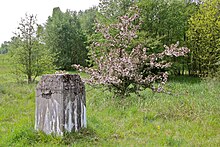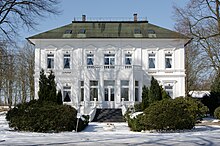Höltigbaum
|
Höltigbaum nature reserve
|
||
|
Typical meadow landscape |
||
| location | Hamburg , Germany | |
| surface | 2.7 km² | |
| WDPA ID | 318567 | |
| Geographical location | 53 ° 38 ' N , 10 ° 12' E | |
|
|
||
| Setup date | 1998 | |
| administration | BSU | |
|
Höltigbaum nature reserve
|
|
| location | Schleswig-Holstein , Germany |
| surface | 2.86 km² |
| WDPA ID | 318566 |
| Setup date | 1998 |
| administration | LLUR |
The Höltigbaum was until 1992 a training area of the Bundeswehr , mainly by the then in Hamburg-Rahlstedt stationed units of the Armored Infantry Brigade 17 was used. Today Höltigbaum is one of the largest nature reserves in Hamburg and is protected according to the European Fauna-Flora-Habitat Directive . It is a transnational protected area on the border with Schleswig-Holstein , its Hamburg parts belong to the Wandsbek district , the Rahlstedt district , the Schleswig-Holstein parts belong to the Stapelfeld municipality in the Stormarn district .
geology
Geologically, the three areas of Höltigbaum, Stellmoorer Tunneltal and Ahrensburg Tunneltal belong together and form a richly structured terminal moraine area of the Vistula Ice Age . The central formation is the eponymous tunnel valley , which extends from Ahrensburg-Hagen to the eastern edges of Rahlstedt and through which the Wandse and Stellmoor source rivers run today .
The Höltigbaum is less richly structured and is a good example of a ground moraine landscape from the last Ice Age.
ecology
The two parts of the protected area differ greatly due to their vegetation. In the Schleswig-Holstein area there is a remarkably large occurrence of the skylark , which finds optimal conditions there as a ground breeder . In contrast, the Hamburg part is dominated by heavy vegetation, which favors the occurrence of the leaf warbler . Overall, there are more species and animals in the Hanseatic city than in the Stormarn area. In the half-open heathland are tree pipit , red-backed shrike , Whitethroat and Goldammer ago in regionally significant population. The reserve is also of great importance for amphibians and insects. A total of 58 plant and 78 animal species on the Red List are protected.
More than forty years of use by the Bundeswehr have had a decisive impact on the vegetation on the Höltigbaum. The areas were hardly fertilized, the vegetation cover was repeatedly destroyed, which meant that short-lived pioneer plants in particular could establish themselves here. On sandy hilltops and sunny slopes, dry grasslands still grow today . The savannah-like grass corridors with red fescue and red ostrich grass are particularly typical . Scattered into the landscape are remnants of sandy and clay heather. For a long time, the existing hedgerows were only managed very sparingly and, in addition to the typical oak, ash, sloe and hawthorn trees, have a high proportion of wild apple trees .
In order to preserve the diversity of the habitat, most of the Höltigbaum has been cultivated since 2000 using the "semi-open pasture landscape" method, extensive year-round grazing with various grazing animals (especially Galloway and Highland cattle and Heidschnucken ).
development
The area where the Höltigbaum is located today was used for agriculture for a long time and was then still called Dänenheide .
In 1937, the local farm owners were expropriated so that the Wehrmacht the area a training area could convert.
From mid-1945, the shooting ranges in the southern part of Höltigbaum were confiscated by the British occupation forces and used for target practice.
In 1958, the Bundeswehr took over the training area, which among other things built a new ammunition depot there.
In 1995 the Bundeswehr announced the abandonment of the military base and began to clear the area. At the same time, an intensive public discussion about the future of the Höltigbaum started. As a result , an industrial area was set up on the south-western part, where the shooting ranges were previously , and the remaining area was placed under protection. Exceptions are the area around the Hamburg-Rahlstedt transmitter , a renovated former blasting site and the former ammunition depot in the Schleswig-Holstein part.
Apart from Panzerstraße and an ammunition depot, only remnants of the military installations are preserved today.
The Stormarn part has been protected since 1997 and covers 286 hectares. The 270 hectare part in Hamburg was placed under protection a year later. The protected area has a total area of 558 ha. It is looked after by the Nature Conservation Union Germany , the Jordsand Association , the German Forest Protection Association , the Nature in the North Foundation , the Hamburg Office for Nature and Resource Protection and the Wandsbek Forestry Office. A large part of the area is owned by the Schleswig-Holstein Nature Conservation Foundation . The ecological importance as well as numerous archaeological settlement finds justify the protection.
The protected area Höltigbaum is spatially closely connected with the nature reserves Stellmoorer Tunneltal and Ahrensburger Tunneltal , both of which are in the immediate vicinity. In many respects it is treated as a unit with the Stellmoorer Tunneltal.
Since 2008 there has been an information and visitor center for the protected area with the "House of the Wild Pastures".
archeology
An Iron Age rural settlement from the 1st century BC was built on the Hagenweg road near the former garbage dump from 1972 to 1988 . Chr. Excavated and extensively documented. Even if no clear traces of houses could be found, water points, stoves, ceramic remains and stone utensils have been found that are comparable to other Iron Age finds in the east of Hamburg . As a special feature, a bulbous ceramic vessel with six handles is mentioned, which has so far been a unique piece in northern Germany in the corresponding period of time.
Firing range memorial site
Towards the end of World War II, the military training area Höltigbaum were many of the shooting ranges courts martial for desertion or sedition sentenced to death soldiers executed . The firing squads were provided from the surrounding barracks. The last shootings took place on April 28, 1945, five days before the arrival of the British troops. The names of 22 executed people who were registered with the Rahlstedt registry office are known . They were simple soldiers, sailors, pioneers and riflemen, also corporal and non-commissioned officers as well as two young officers. It is estimated that around 330 deserters were shot dead. After the exercise area was abandoned, a memorial plaque was attached to this site on September 5, 2003 as part of the plaque program of the Hamburg cultural authority to commemorate the soldiers who were persecuted and killed for their refusal to continue military service for the Nazi tyranny. The Rahlstedter Kulturverein eV took the initiative and set up the Höltigbaum information board on September 5, 2003. Rahlstedter local politics has joined the initiative. The deserter memorial is in the planning stage.
Origin of the name Höltigbaum
The L222 runs southeast of the Höltigbaum, a country road between Hamburg and Lübeck for centuries. From 1788 to 1837 there was an estate here ( 53 ° 36 ′ 33.2 ″ N , 10 ° 11 ′ 29.4 ″ E ) with a customs post and a barrier . The current name of the area is derived from the Low German name for this “holding tree”.
Photographs
See also
- Ahrensburg tunnel valley
- Stellmoorer Tunneltal nature reserve
- List of nature reserves in Hamburg
- List of nature reserves in Schleswig-Holstein
- Hamburg memorials for the victims of National Socialism
literature
- Kai Schmille: The Hamburg nature reserves . Edition Temmen , Bremen 2011, ISBN 978-3-8378-2015-7 , pp. 163-171 .
- Werner Jansen: The Stellmoorer Tunneltal and Höltigbaum nature reserves . In: Rahlstedter Yearbook for History & Culture . No. 5 . Rahlstedter Kulturverein, 2003, p. 68-71 ( online [accessed January 31, 2012]).
- Friedrich Grube: Glaciers shaped the Rahlstedt landscape . In: Rahlstedter Yearbook for History & Culture . No. 8 . Rahlstedter Kulturverein, 2006, p. 34-46 .
- Wulf Thieme: The excavation of a prehistoric settlement on Hagenweg in Hamburg-Meiendorf . In: Rahlstedter Yearbook for History & Culture . No. 10 . Rahlstedter Kulturverein, 2008, p. 22–34 ( online [accessed February 2, 2012]).
- Hamburg Environment Authority, Nature Conservation Office (publisher): Nature reserves Höltigbaum Stellmoorer Tunneltal (Map 1: 10,000 with explanations) . Hamburg Environment Agency, Hamburg 1999.
- District Assembly Wandsbek and State Center for Political Education : Commemoration at Höltigbaum, Rita Bake editorial staff , Hamburg 2012.
Individual evidence
- ^ Münch: Use of the Höltigbaum shooting range, Hamburg-Rahlstedt, by the occupying forces. , dated August 18, 1951
- ↑ a b Ordinance on the Höltigbaum nature reserve in the version of April 24, 2012 , accessed on July 5, 2012
- ^ "House of the wild pastures" on hamburg.de, accessed on February 1, 2012
- ↑ taz article from July 21, 2009: The Honorable Traitors , accessed on February 20, 2010
- ↑ http://www.rahlstedter-kulturverein.de/ (yearbook 2004 - speech for the inauguration of the table by district office manager Gerhard Fuchs).
- ↑ Memorials in Hamburg, Höltigbaum shooting range ( memento from November 23, 2015 in the Internet Archive ), accessed on July 10, 2012
- ↑ History of the Höltigbaum on www.jordsand.eu (accessed on March 10, 2013)
Web links
- Jordsand Association for the Protection of Sea Birds and Nature eV
- Cattle drive on the Höltigbaum - cattle and sheep eat for nature conservation
- Stiftung Naturschutz Schleswig-Holstein (responsible for the integrated Höltigbaum station)
- Höltigbaum - A strong piece of Stormarn ...
- Vogelwelt am Höltigbaum (from: "Discover Hamburg's bird world" by Thomas Schmidt)
- The Höltigbaum nature reserve
- NABU on the Höltigbaum
- NABU Hamburg ( memento of October 29, 2008 in the Internet Archive ) on projects in the Höltigbaum












